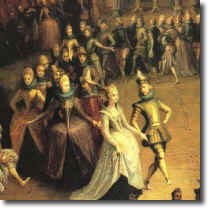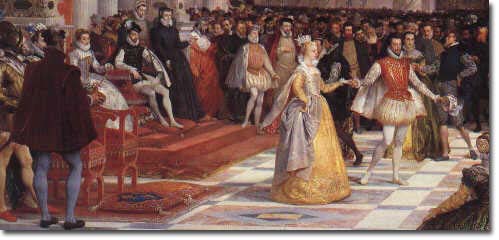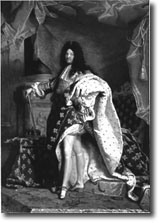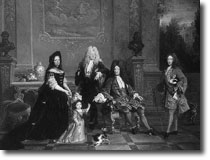Past Salon Pictures
LATE RENAISSANCE / ELIZABETHAN SALON
Elizabethan England in the year of 1586
This is an international gathering arranged by Elizabeth the First and her
Privy Council to possibly deal with the succession to Elizabeth's Throne.

|
A Salon Project
The Salon Project Level III of The Williamson Technique is unique among methods for training actors in period movement. The guiding concept is that an actor learns the style of an era by living in the era that produced the style. It is designed to give actors a comprehensive understanding of the epoch that they are studying. Out of this comprehensive foundation, the actor develops the physical style of social behavior of that epoch. It is a resource exercise that is constructed out of what the actors themselves bring to the class. They do extensive research in the liberal arts of the era: history (especially biography), political diplomacy, literature, religion, theater, art, music, dance, architecture, dress or fashion, culture and games.
|
The Physical Elements
In the Physical Technique of Style, the actors Learn:
1. deportment: the grace of style in which one carries (deports)
oneself in walking and sitting, execution of bows, and in use of the
clothing of the era;
2. Choreography for bows and other forms of greeting and taking leave.
3. clothes usage: the specific skills required by the convention of the
era when using such items of clothing as the corset (particular to the style
of each era), the train of a dress, various foundation garments specific to
the era, heeled shoes for men and women, fans, gloves, hats, wigs, canes,
handkerchiefs, etc.
4. furniture usage: the posture and carriage required by the chairs,
sofas, etc.
5. etiquette: the codes of politeness when using the skills listed in one
and two.
6. Protocol: the use of etiquette and deportment according to the rank of
the person in the social structure.
7. The physical life of the characters.
In every case the actors use the central aspects of The Williamson
Technique: the physical methods for opening up and taking in the sensory
world; mastery of physical form in alignment; free and spontaneous
breathing; etc. Within the structure of the Technique, this is the most
demanding of the character projects. It is designed to accompany the
semesters where the physical technique work concentrates on the form of an
actor's behavior.
8. The social dancing: Here the actors learn the dances of the era and the
etiquette and protocol that attends social dancing. The dancing is a major
factor in understanding an era. The very form of the dance and the posture
of the person dancing give the actor a deeper understanding of the
deportment of the era. A late Nineteenth Century waltz gives a unique rhythm
and grace to the physical life of anyone who dances it. It also demands
posture that is unique to the era.

9. The Music of an era: The dancing is of major importance in understanding
the music of the era. The actors interact with the music of the period with
a deep kinesthetic truthfulness. It gives an understanding of the music
that far exceeds the limitations of just listening to the sounds of it. It
comes alive in their bodies. They come into a rich contact with the soul of
the music. The very form of the dance and the posture of the person dancing
give the actor a deeper understanding of the deportment of the era. It also
demands posture that is unique to the era. Also, dancing inspires social
interaction that helps an actor to discover the inner life of the characters
and their relationships.
Baroque and Restoration Style Salon:
The style project accompanies either Level IIIA or Level IV Class. The actor researches and develops a character through historical and cultural
etiquette, manners, protocol, dances, clothes, cultural, and social relationships of the period. The period characters are created using the principles of the Technique
such as: sensual contact, open range of sound, and physical alignment.
 Louis XIV(1670) Louis XIV(1670) |
Period Character
Period Dance
Period Music
Period Costumes
Period Text
Courtly Manners
Historical Research
|

| In a period style class the actors create a character from another culture and century, they develop a historic personage of the period and courts of: Elizabeth
I of England (1586), Louis XIV and Charles II (1670) and Queen Victoria of England (1894)
|
Baroque Coaching Style Review
Edwardian Salon: (Ted Morin, Janice Orlandi)
"The most outstanding value of a Period Style class is that it produces actors that move and live within the style of a period with total truthfulness, vocal freedom, physical grace and ease. Actors learn to create an expansive character free from the limits of their everyday physical and vocal habits. Immersed in the circumstances of the place and time of an era, the actors as an ensemble create an imaginary world.” - Janice Orlandi, SHOWBUSINESS
A Style Salon: is an exercise that takes the student into the world of the play creating a character from the period in which a playwright sets the play. Students experience both the inner and outer elements of a specific period(e.g. Edwardian).
Outer elements of style include: the costumes, the dances, the social language, and all of the objects that outwardly inform the student’s treatment of environmental elements such as the set and props.
Inner elements of the style include: a sense of space, grace and ease in formal situations, and all that creates the upper class, aristocracy, and royal class.
The students explore the inner and outer life elements of the characters in their gestures, deportment, dances, etc. this work culminates in an improvisational Period Style Salon Presentation. Because students work with images of real people that were actually connected to one another historically, their meeting, and the Salon itself, could theoretically re-write history.
Elements covered are:
-
Period Character
-
Period music
-
Period costume
-
Period text
-
Period props
-
Period Games
-
Period social protocol
-
Period dance
Curriculum includes: A Baroque and Elizabethan Period Style workshops. The emphasis of the workshops will be on the many differences between the eras presided over by Elizabeth I of England (1586), Louis XIV of France (1670), and Queen Victoria of England (1894).
Nicholas & Alexandra Romanov (1894)
Queen Victoria of England, Prince & Princess of Wales
Wilhelm II, Kaiser of Germany
|